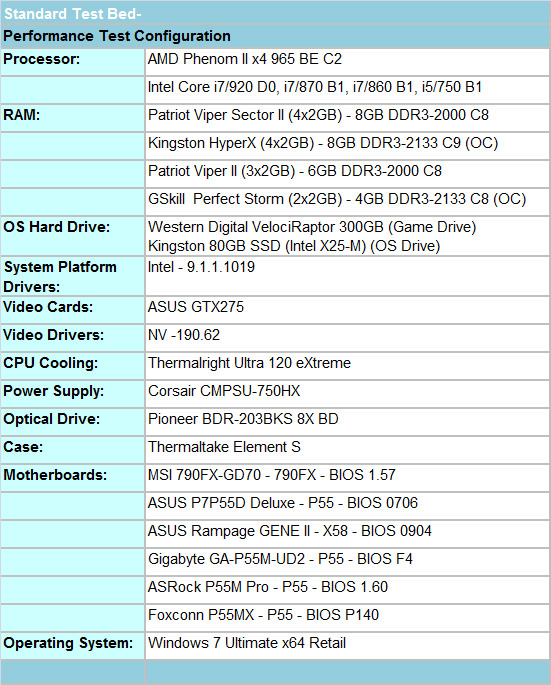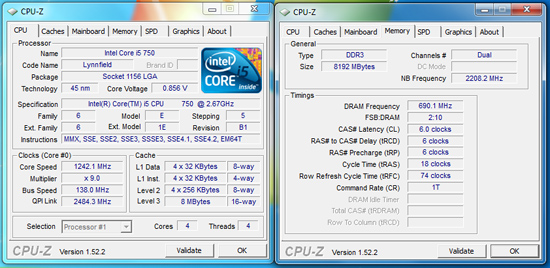Budget Micro-ATX P55 Faceoff: Gigabyte GA-P55M-UD2 and ASRock P55M Pro
by Gary Key on October 5, 2009 12:30 PM EST- Posted in
- Motherboards
Test Setup -

We utilized a wide variety of memory kits from Corsair, OCZ, Patriot, GSkill, Kingston, and Super Talent to verify memory compatibility on our test boards. Our OS and primary applications were loaded on the Kingston 80GB SSD drive and our games were operated off the WD 300GB VRaptor drive. We did a clean install of the OS and applications for each motherboard.
We chose the ASUS GTX275 video card and Corsair’s 750HX power supply. Yes, a 750W power supply is overkill for our micro-ATX boards, but will be required when we test CF/SLI in future P55 reviews. The difference in power consumption was under 1.5W on average between the 750HX and 520HX power supply.
Our air cooler of choice is Thermalright’s Ultra 120 eXtreme, primarily for its exceptional performance during our overclocking tests. We also tested with the retail cooler and those results along with direct CPU comparisons can be found here.
We are providing initial test results with Foxconn’s P55MX. Our test sample had an early revision P55 chipset and the retail board just arrived. Our application and game benchmarks are with the retail board. The board is limited to 4GB of memory in our tests due to the dual slot design. Our multitask test had two applications removed to bring the memory required footprint down to 3.82GB. An article update will be generated once we complete our overclocking and stability tests. This board sells for around $90 and is really designed for the business or SOHO user.
Our 790FX/X58 results are provided for comparison only. For our test results we setup each board as closely as possible in regards to memory timings. Otherwise all other settings are left on auto. The P55 and 790FX motherboards utilized 8GB of DDR3, while the X58 platform contained 6GB. The P55 and X58 DDR3 timings were set to 7-7-7-20 1T at DDR3-1600 for the i7/920, i7/870, and i7/860 processors at both stock and overclocked CPU settings.
We used DDR3-1333 6-6-6-18 1T timings for the i5/750 stock setup as DDR3-1600 is not natively supported in current BIOS releases for this processor at a stock Bclk setting of 133. We had early BIOS releases that offered the native 1600 setting but stability was a serious problem and support was pulled for the time being. Performance is essentially the same between the two settings.
The AMD 790FX setup is slightly different as trying to run DDR3-1600 at CAS 7 timings on the 1:4 divider is extremely difficult. DDR3-1600 is not natively supported on the Phenom II series so this divider is provided with a caveat that you are overclocking the memory bus. The same holds true for the Lynnfield (i7/8xx, i5/7xx) processors as DDR3-1333 is officially the highest memory speed supported and it is DDR3-1066 for the Bloomfield (i7/9xx).
Without resorting to some serious overvolting and relaxing of sub-timings, we set our AMD board up at DDR3-1600 8-8-8-20 1T timings. The difference in performance between C7 and C8 DDR3-1600 is practically immeasurable in applications and games on this platform. You might pick up an additional few tenths of second in SuperPi or a couple of extra points in AquaMark or 3DMark 2001SE, but otherwise performance is about equal.
However, in order to satisfy some of our more enthusiastic AMD supporters, we also increased our Northbridge speed from 2000MHz to 2200MHz to equalize, if not improve, our memory performance on the AMD system. Yes, we know, further increasing the NB speed will certainly result in additional performance but the focus of this short article is to show clock for clock results at like settings. Personally, I would run DDR3-1333 C6 with 8GB as this platform favors tighter timings over pure bandwidth.
We will provide P45/Q9550 platform results in the next roundup.
I know what you did last BIOS release...

One problem we constantly ran across in early testing and major reason why we delayed the start of these roundups was the floating Bclk problem. Motherboard suppliers have tweaked FSB speeds for years in an attempt to squeeze out that last little bit of performance at stock speeds. Well, the same thought process went into a few of the P55 BIOS releases from several manufacturers.
Even though we manually set the Bclk rates to 133, a few of the boards decided to still float the Bclk rates up to 138 in some cases, 136 in others. If the manufacturer did not change their BIOS to lock Bclk rates at 133 when manually set to 133, then we set the boards to 132. That in its self caused a few quick BIOS updates and except for one upcoming board, we are no longer experiencing this problem.










55 Comments
View All Comments
yacoub - Tuesday, October 6, 2009 - link
785G is just onboard graphics halfbreed between 780 and 790 or whatever. until AMD releases a new line of high-end boards worth reviewing, why bother?haplo602 - Wednesday, October 7, 2009 - link
P55 is just half a chipset, i5 took over some of the functionality anyway ... why bother ?tommy101 - Wednesday, September 8, 2010 - link
beastyhacks79.smfnew.com the best psp hacking sitebollux78 - Tuesday, October 6, 2009 - link
Why do we need PCI anymore? I´ll tel you why: The PCI bus is more than enough for a hell bunch of applications, that´s it. If you have a damn good sound card or video capture, or whatever the card you have, and it´s PCI, you´d love to have the slot in there, because you don need to ditch that card and bet a "fantastic" PCIE x1 new card.C´mon people, let´s use the computer for the right purpose, not just to give money to the manufacturers buying new parts that you don´t
necessarily need.
I know, I´m being inflexible and oldschool, but, please, evolution is one thing, marketing is a completely different animal.
strikeback03 - Tuesday, October 6, 2009 - link
IMO it is more a board real estate problem than a case of buying the latest and greatest. On these P55 uATX boards you have 4 slots, one of which has to be devoted to graphics unless it is a headless server. If you use a dual slot graphics card (which a substantial portion of the readers on this site) you lose a second slot, and ideally you would have an open slot beneath that to ease airflow. So that leaves you with one or in a pinch two slots, therefore what interface they are is quite important. PCIe has been out on boards for what, 5-6 years now? I'd say its time to stop selling PCI cards and leave the PCI slots only on full ATX boards (plus maybe a few HTPC-oriented uATX boards) and let the interface finally die off.Though I'd say IDE has even less of a place now, SATA hard drives have been the norm for years and even optical drives for a few years. Time to upgrade if you are still carting one of those around.
sonicdeth - Monday, October 5, 2009 - link
Thanks Gary for the detailed review. Can't wait for the p55 roundup, and I'm also very interested now in your audo codec review.mindless1 - Monday, October 5, 2009 - link
... but I don't see the sense in SLI on mATX. Using the typical long video cards means you can't have a shorter depth case, just shorter height and since when is the area above your computer case a vital piece of real-estate?With 2, 8 or 16X slots onboard it only makes sense to me to go full ATX, is someone with the system budget to build a powerhouse gaming machine really poor enough, indescriminating enough, or young enough (to not have desirable cards from past systems) they don't want to add some other cards?
I hate to say it but this is getting to be a madness, the idea that we need to focus centrally on gaming ability of a board. Most people are not hard core gamers, but factually speaking, most hard core gamers don't do SLI either. Granted you can use a 16x slot for cards with fewer lanes, that seems the only saving grace for the two boards.
It's getting to the point I want a cTX case design where the drive racks are not in front of the mainboard and PSU, they are above them, so the case is even taller than std. ATX but not as deep.
Might tip over a little easier but earthquakes are rare here and plenty of other household items are more tip-happy than that would be.
strikeback03 - Monday, October 5, 2009 - link
There are cases made to hold a uATX board lying on the bottom, making it kinda a wider Shuttle. I'm personally looking for full ATX as well though, as the height doesn't matter too much to me (pretty sure anything short of a ABS Canyon or some of the bizarre decorative cases would fit under my desk) and don't want to limit my slot selection.Sunburn74 - Monday, October 5, 2009 - link
Hey Anand,Gigabyte boards have on issue that drives me nuts. As soon as you start overclocking them, you lose the ability to S3 sleep. When you do your maximal overclocks for various board reviews, would you mind testing if S3 sleep was maintained at those maximal overclocks?
Gary Key - Monday, October 5, 2009 - link
This board resumes from S3 (USB keyboard) at up to 215 Bclk (mentioned in the thoughts section, make that more visible next time) with our setup and that includes an external hard drive on the Firewire port which is properly instructed to shut down and restart.